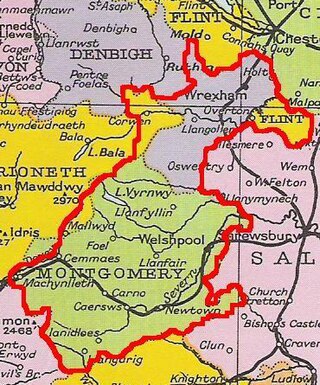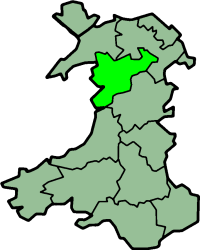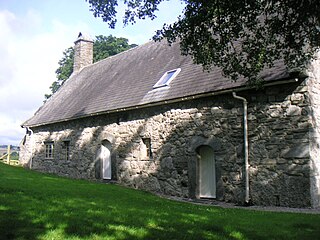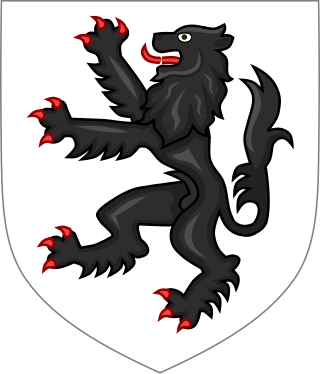
Until 1974, Merionethshire or Merioneth was an administrative county in the north-west of Wales, later classed as one of the thirteen historic counties of Wales.

Sir John Wynn, 1st Baronet, was a Welsh baronet, Member of Parliament and antiquary.

Madog ap Maredudd was the last prince of the entire Kingdom of Powys, Wales. He held for a time, the FitzAlan Lordship of Oswestry, family of the Earls of Arundel, of Arundel Castle. His daughter married Lord Rhys, Prince of Wales.

Powys Fadog was the northern portion of the former princely realm of Powys. The princes of Powys Fadog would build their royal seat at Castell Dinas Brân, and their religious center at Valle Crucis Abbey. Some of its lordships included those of Maelor, Mochnant, Glyndyfrdwy, Yale, and Bromfield and Yale. Following the division of Powys, their cousin branch, the princes of Powys Wenwynwyn, would build Powis Castle.

Hughes of Gwerclas were a native Welsh royal family descended from prince Owain Brogyntyn the illegitimate but acknowledged son of prince Madog ap Maredudd by a daughter of the "Maer du" or "black mayor" of Rûg in Edernion. His father granted to him and his successors the Cantref of Edeyrnion and the Lordship of Dinmael. These areas were both remote frontier lands situated between Powys and the neighbouring ascendant Kingdom of Gwynedd. From the earlier part of the 12th Century both lordships usually paid homage to Gwynedd.

Owain Brogyntyn ap Madog was prince of Powys and the third and illegitimate son of king Madog ap Maredudd, the last king of a united Kingdom of Powys. He was the son of Madog by the daughter of the Maer du or "black mayor" of Rûg in Edeyrnion however some sources cite his mother as Susanna making him legitimate instead. He was the brother of Gruffydd Maelor the ancestor of Owain Glyndŵr. Presumably Owain Brogyntyn would have been raised by his mother at Rûg in Edeyrnion. He was acknowledged by his father and granted by him the lordship of Edeyrnion and also Dinmael. It is quite possible that he inherited some of these lands through his maternal grandfather, the Maer Du, which were confirmed and perhaps extended by his father the king of Powys. At some point he also came into possession of Castle Brogyntyn on the English borders at Selattyn close to Oswestry.

Rhug is a township in the parish of Corwen, Denbighshire, Wales, formerly in the old cantref of Edeirnion and later a part of Merionethshire, two miles from Corwen and ten miles north east of Bala. It includes the hamlet of Bonwen. It is situated near the River Dee, under Berwyn range. About 1150, it was ruled by the Maer Du or "Black Mayor of Rhug" and later became part of the lands of the barons of Edeirnion who ruled from Gwerclas Castle.

Edeirnion or Edeyrnion is an area of the county of Denbighshire and an ancient commote of medieval Wales in the cantref of Penllyn. According to tradition, it was named after its eponymous founder Edern or Edeyrn. It was included as a Welsh territory of Shropshire in the Domesday Book.

The Royal House of Mathrafal began as a cadet branch of the Welsh Royal House of Dinefwr, taking their name from Mathrafal Castle. They effectively replaced the House of Gwertherion, who had been ruling the Kingdom of Powys since late Roman Britain, through the politically advantageous marriage of an ancestor, Merfyn the Oppressor. King Bleddyn ap Cynfyn would join the resistance of the Anglo-Saxon King Harold Godwinson, against the invasion of William the Conqueror, following the Norman conquest of England. Thereafter, they would struggle with the Plantagenets and the remaining Welsh Royal houses for the control of Wales. Although their fortunes rose and fell over the generations, they are primarily remembered as Kings of Powys and last native Prince of Wales.

Anwyl of Tywyn are a Welsh family who claim a patrilinear descent from Owain Gwynedd, King of Gwynedd from 1137 to 1170 and a scion of the royal House of Aberffraw. The family motto is: Eryr eryrod Eryri, which translates as "The Eagle of the Eagles of Snowdonia. The family lives in Gwynedd and speak Welsh.

Plas Uchaf is a 15th-century cruck-and-aisle-truss hall house, 1.5 miles (2.4 km) south-west of Corwen, Denbighshire, Wales and 1 mile (1.6 km) north of Cynwyd. Its excellent workmanship indicates a house originally of considerable importance; it has been described as "of palatial significance".

Penllyn was a medieval cantref originally in the Kingdom of Powys but annexed to the Kingdom of Gwynedd. It consisted of the commotes of Edeyrnion, Dinmael, Penllyn is Treweryn and Penllyn uwch Treweryn.
Nathanael Jones, Esq., of Hendwr, Merionethshire, was a Welsh gentleman-poet.

The Jones of Hendwr, and later Faerdref Uchaf, family is a Welsh gentry family from the parish of Llandrillo-yn-Edeirnion, Merionethshire, descended from the 4th Baron of Hendwr. 'Yr Hendwr' means 'the Old Tower' in Welsh and is visually represented by the crest of the Jones of Hendwr family.

Baron of Hendwr, in the County of Merioneth, is a dormant title in the English Baronage which was created on 22 July 1284 for Dafydd ap Gruffydd ap Owain Brogyntyn by letters patent issued by Edward I at Caenarfon. Dafydd and his cousins were great grandchildren of Madog ap Maredudd, King of Powys, and had fought against Edward I during his Conquest of Wales. After coming into the King's Peace, they received a Royal pardon and were among the few members of the old Welsh royal dynasties to have their lands confirmed per Baroniam.
Giwn Lloyd, 18th Baron of Hendwr (1699–1774) and squire of Tyfos, in the county of Merioneth and of Gwersyllt Park and Plas Newydd, in the county of Denbigh, was a Welsh gentleman who lived in the 18th century and was notorious for his dissolute life. He is best remembered for the lengthy court battle which ensued after his death, lasting over twenty years, exhausting the finances of many of his kinsmen, and shocking much of Welsh society.

Ellis ap Griffith or Elissau ap Gruffudd, was the Baron of Gwyddelwern in Denbighshire, Wales, and the grandnephew of Owen Glendower, Prince of Wales. Following his family defeat during the Glyndwr Rising, his branch inherited the co-representation of the Royal House of Mathrafal, and were immortalized by William Shakespeare in the history play Henry IV. Through his mother Lowrie, he inherited the lordship of his grandfather, Tudor Glendower, and by marriage, the estate of Plas-yn-Yale. By this union, he became the founder of the House of Yale, represented by the Yale family, later known in America as the benefactors of Yale University.

Reverend John Yale was a British cleric and Rector of Lawford in Essex. He was made Steward and Chaplain of Horningsea in the city of Cambridge, and later, became Deacon and Fellow of the University of Cambridge. Notably, he was the heir to the Plas-yn-Yale estate in Wales of the Yale family, which was succeeded by his sister Sarah Yale, last of the direct male line. After her death, her cousin Col. William Parry Yale succeeded to the estate.
















